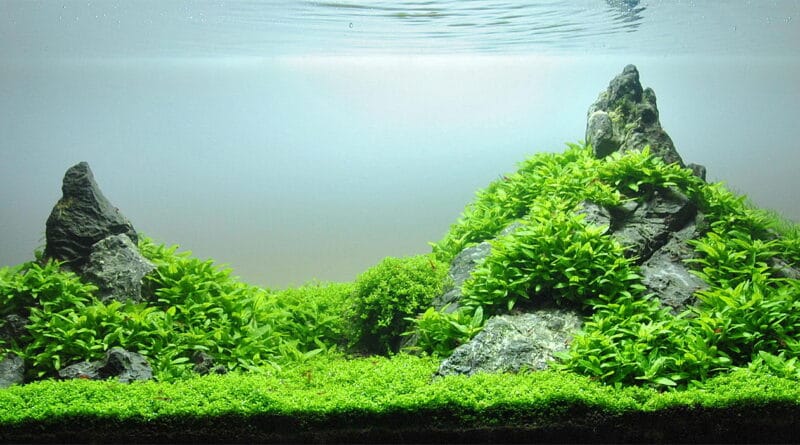Best Carpet Plants for Aquariums: 7 Stunning Options for Any Setup
🌱 Introduction: Why Carpet Plants Matter in an Aquarium
When it comes to creating a truly captivating freshwater aquarium, carpet plants are one of the most effective ways to elevate your aquascape. These low-growing, spreading plants cover the substrate with a lush, green layer, mimicking the grassy floors of natural rivers and lakes. Not only do they transform your tank into a vibrant underwater garden, but they also improve water quality and provide shelter for small fish, shrimp, and fry.
Whether you’re running a high-tech planted tank with CO₂ injection and strong lighting, or a more laid-back, low-tech setup, there are carpet plant options that can suit your needs. In this guide, we’ll walk you through the best carpet plants for aquariums, including easy, low-maintenance varieties as well as high-demand, competition-grade choices.
By the end of this article, you’ll know which carpet plants work best for your aquarium’s conditions — and how to choose the perfect one to create a stunning aquatic landscape.
For beginners, our guide to the best beginner aquarium plants is a great place to start.
🌱 What Are Carpet Plants?
Carpet plants are a special category of aquatic plants used primarily in the foreground of aquascapes to create a dense, grassy covering over the substrate. Unlike taller stem plants or bushy midground varieties, carpet plants stay low to the ground, spreading horizontally rather than growing upward.
In a well-designed aquarium, carpet plants serve as the “floor” of the scene — providing a naturalistic base that complements rocks, driftwood, and taller background plants. They’re an essential element in popular aquascaping styles like the Iwagumi and Nature Aquarium, where simplicity and balance are key.
Carpet plants are often referred to by other names as well, such as aquarium ground cover plants, aquarium grass carpet, or foreground plants. While all carpeting plants share the same purpose, they vary greatly in terms of care requirements, growth speed, and appearance — making it easy to find one that suits both high-tech and low-tech setups.
🌱 Benefits of Carpet Plants
Incorporating carpet plants into your freshwater aquarium offers more than just good looks — they bring a range of practical benefits for your aquatic environment:
✨ 1. Aesthetic Appeal
Carpet plants create a lush, natural base that transforms the look of your tank. Whether you prefer a clean Iwagumi layout or a dense jungle aquascape, a healthy carpet adds depth, balance, and a sense of scale to your design.
🐠 2. Shelter for Shrimp, Fry, and Bottom Dwellers
A dense carpet provides excellent cover for small creatures like shrimp, fry, and timid bottom-dwelling fish. This can reduce stress and encourage more natural behaviours. Many aquarists choose carpet plants specifically because they make ideal habitats for shrimp while still looking beautiful.
🌊 3. Improved Water Quality
Like all live plants, carpeting species help absorb excess nutrients from the water, reducing the risk of algae blooms and contributing to a healthier tank overall.
🪴 4. Substrate Stabilisation
Carpet plants’ root systems help anchor the substrate, preventing it from shifting or clouding the water — especially useful in tanks with strong currents or active fish.
By choosing the right carpet plant, you can enjoy all these benefits while enhancing the visual harmony of your aquarium.
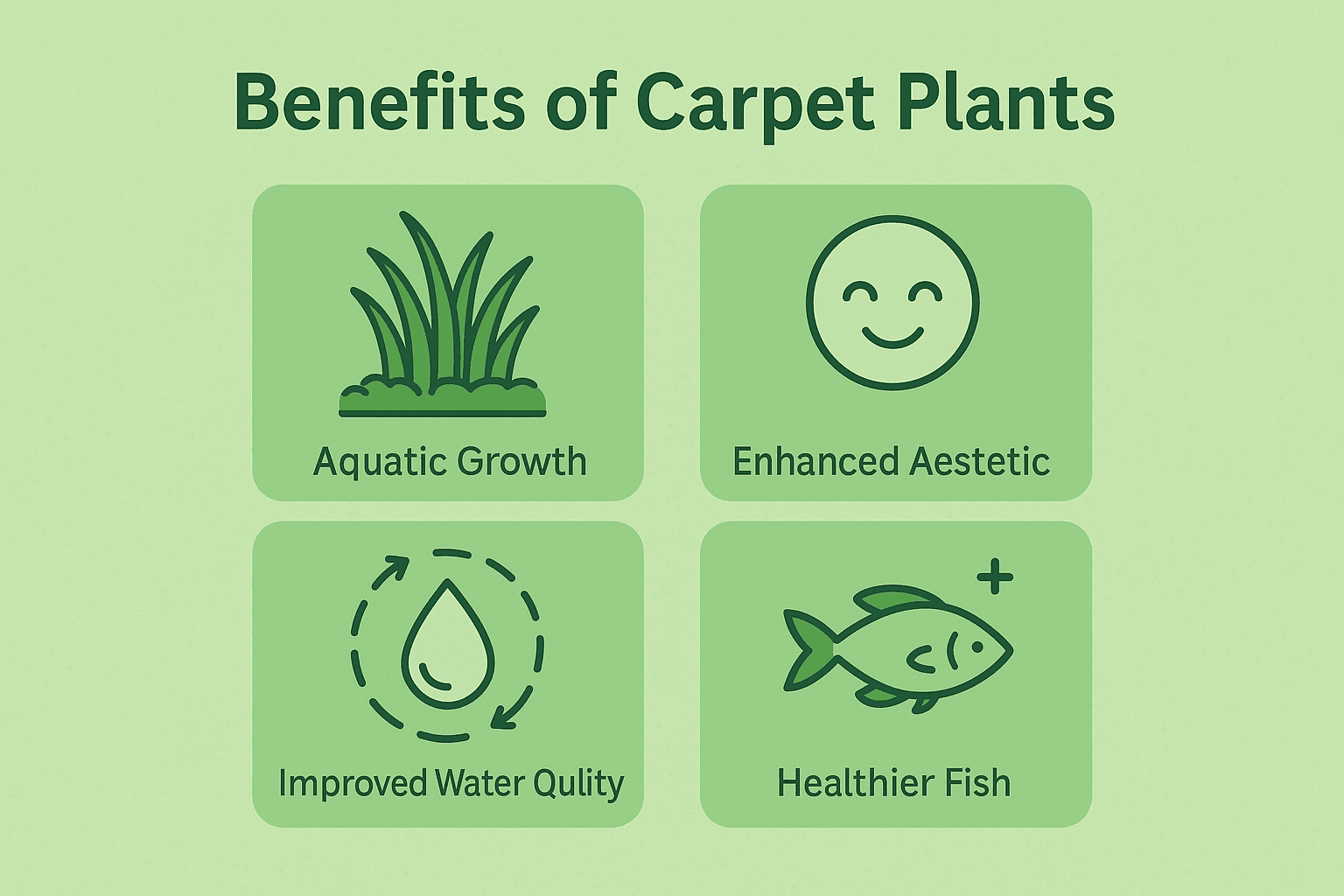
🌱 Factors to Consider When Choosing Carpet Plants
Not all carpet plants are created equal — and the best choice for your aquarium depends on your setup, experience level, and design goals. Here are the key factors to keep in mind before selecting your carpet plants:
💡 Lighting Requirements
Carpet plants typically need bright lighting to thrive, as their low, dense growth means light has to reach all the way to the substrate.
- Low-light carpet plants aquarium options, like Marsilea hirsuta and Cryptocoryne parva, can grow in dimmer conditions, though slowly.
- Demanding species like Glossostigma elatinoides need intense, evenly distributed light for a dense carpet.
💨 CO₂ Requirements
Many of the more delicate and fast-growing carpet plants require CO₂ injection to grow properly and avoid melting.
- Aquarium carpet plants without CO₂, such as Dwarf Sagittaria and Staurogyne repens, are better suited to low-tech tanks, though growth is slower.
- High-tech tanks with CO₂ open up more options and faster results.
🪴 Maintenance Level
Some carpeting species grow quickly and require frequent trimming, while others grow more slowly and are easier to manage. For beginners, slower, hardier plants are usually preferable to avoid frustration.
📐 Tank Size and Scale
Low-growing, fine-leafed carpets look stunning in small, shallow tanks (nano aquariums) and help create the illusion of space. In larger tanks, you may prefer taller, more robust carpeting plants that won’t get lost in the layout.
By considering these factors, you can choose the right carpet plant that matches your aquarium’s conditions and your own aquascaping style.
🌱 Best Carpet Plants for Aquariums
Here’s a closer look at some of the best carpet plants you can choose, whether you’re running a high-tech tank with CO₂ or a more relaxed, low-tech setup. Each of these plants has unique qualities, making it easier to find the right fit for your aquarium.
⭐ 1. Dwarf Sagittaria (Sagittaria subulata)
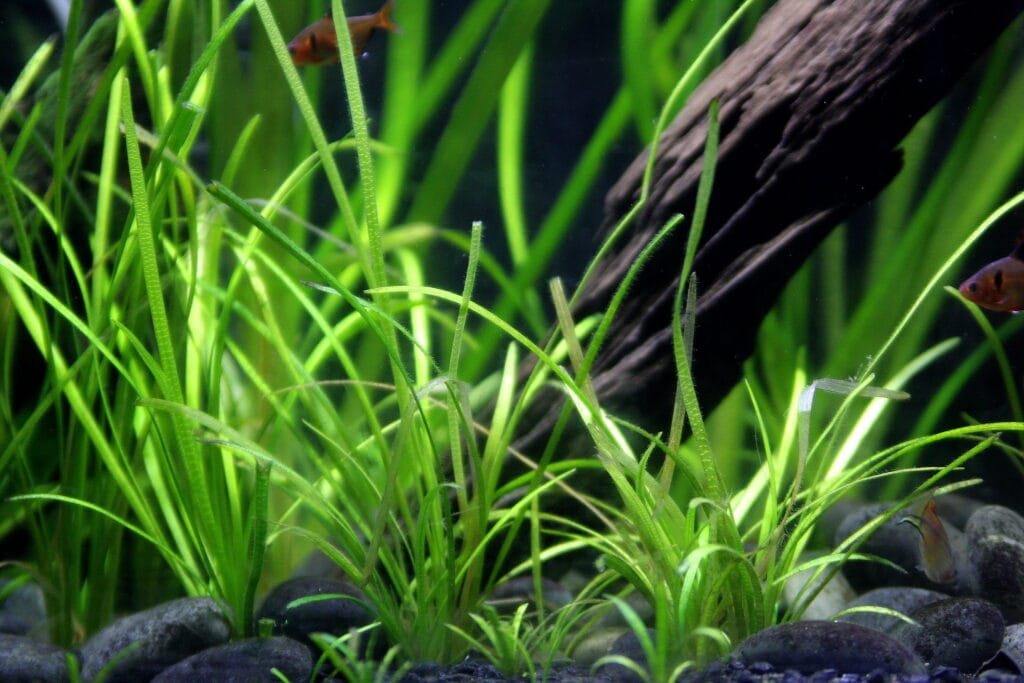
One of the easiest carpeting plants for beginners, Dwarf Sagittaria is hardy, adaptable, and can tolerate a wide range of conditions. It thrives even in low-tech tanks without CO₂, though growth is faster and denser with better lighting and nutrients.
✅ Best for: Low-tech and high-tech tanks
✅ Lighting: Moderate to high
✅ CO₂: Optional
✅ Growth rate: Moderate
✅ Why choose it: Great grassy look with minimal maintenance.
⭐ 2. Marsilea hirsuta
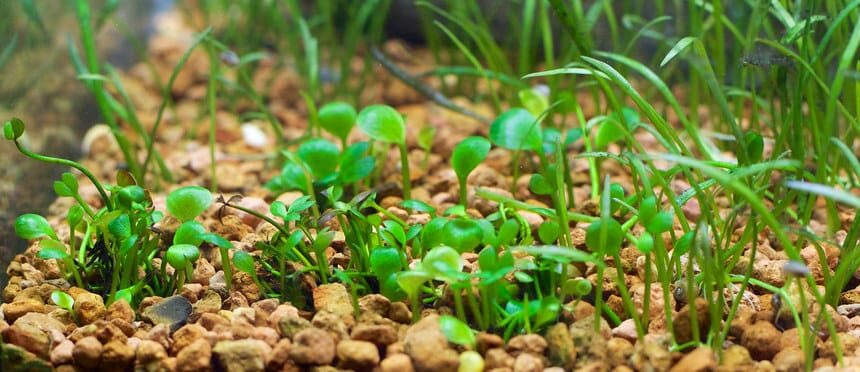
Marsilea hirsuta is a forgiving carpet plant ideal for aquarists who want a lush green carpet without the heavy demands of more delicate species. While it can survive in low-tech tanks, it tends to grow sparse and upright under low light. Providing moderate to high light encourages a denser, more horizontal carpet.
✅ Best for: Low-tech tanks and beginners
✅ Lighting: Moderate to high
✅ CO₂: Optional
✅ Growth rate: Slow
✅ Why choose it: Resilient and beginner-friendly, with better results under good lighting.
⭐ 3. Monte Carlo (Micranthemum tweediei)
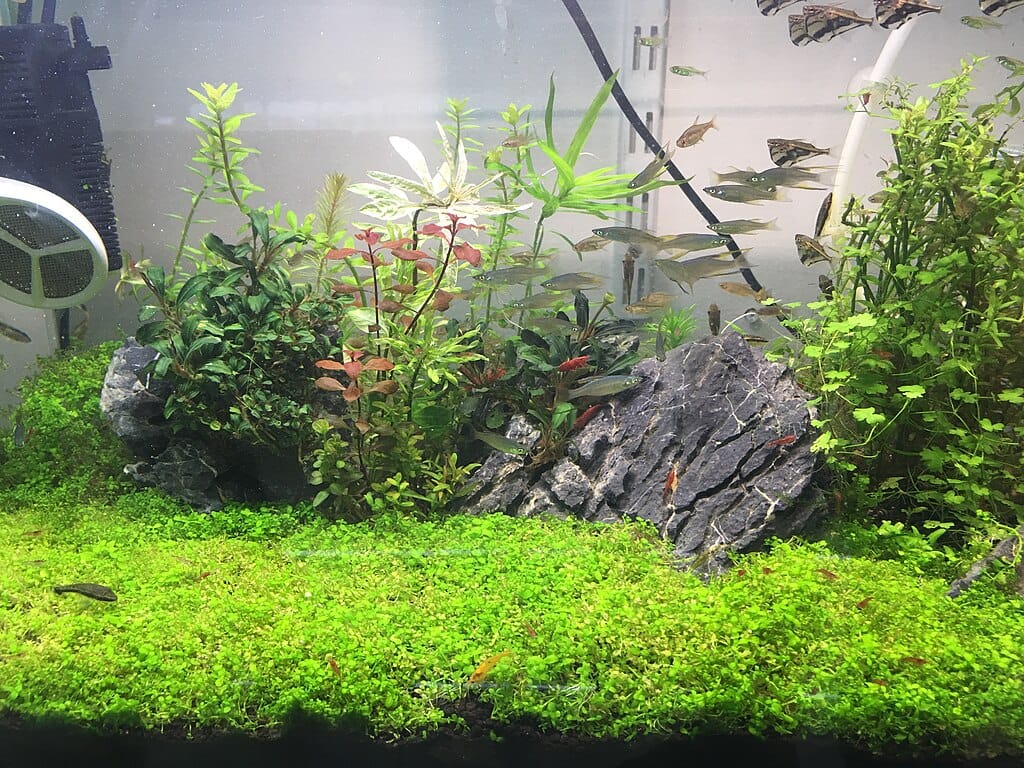
Monte Carlo is a favourite among aquascapers for its bright green, dense carpet that grows faster and is easier to manage than Glossostigma. While it does best with CO₂ and good lighting, it can adapt to low-tech tanks with slower growth.
✅ Best for: High-tech tanks (can work in low-tech)
✅ Lighting: Moderate to high
✅ CO₂: Recommended
✅ Growth rate: Fast (with CO₂)
✅ Why choose it: Beautiful, soft texture and less demanding than Glosso.
⭐ 4. Glossostigma elatinoides
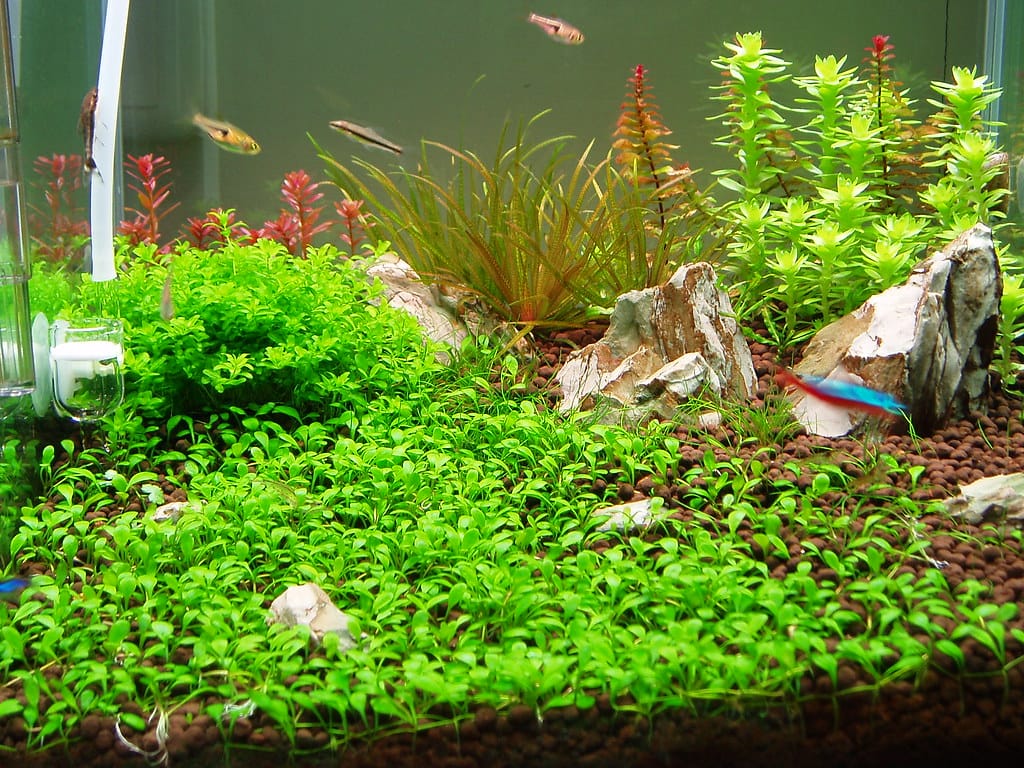
Glossostigma is a classic choice in aquascaping competitions for its striking, bright green, low-lying carpet. However, it’s demanding — requiring high light, CO₂, and careful maintenance to prevent it from growing upward instead of outward.
✅ Best for: High-tech tanks and experienced hobbyists
✅ Lighting: High
✅ CO₂: Required
✅ Growth rate: Fast
✅ Why choose it: Iconic look in professional aquascapes.
⭐ 5. Dwarf Hairgrass (Eleocharis sp.)
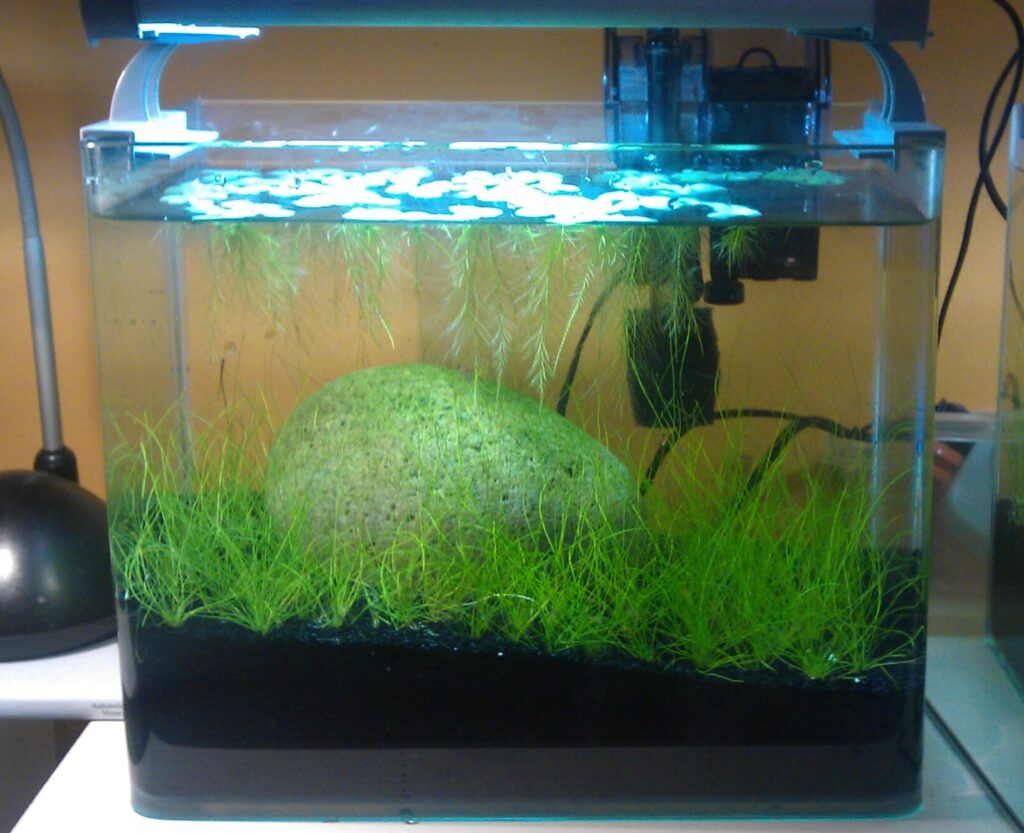
Dwarf Hairgrass is a popular choice for creating a natural, grass-like carpet. It spreads through runners and fills in nicely when provided with CO₂ and high light. It can survive in low-tech tanks, though growth is much slower.
✅ Best for: High-tech tanks (slow in low-tech)
✅ Lighting: High
✅ CO₂: Recommended
✅ Growth rate: Moderate to fast
✅ Why choose it: Classic grassy look and easy to trim.
⭐ 6. Staurogyne repens
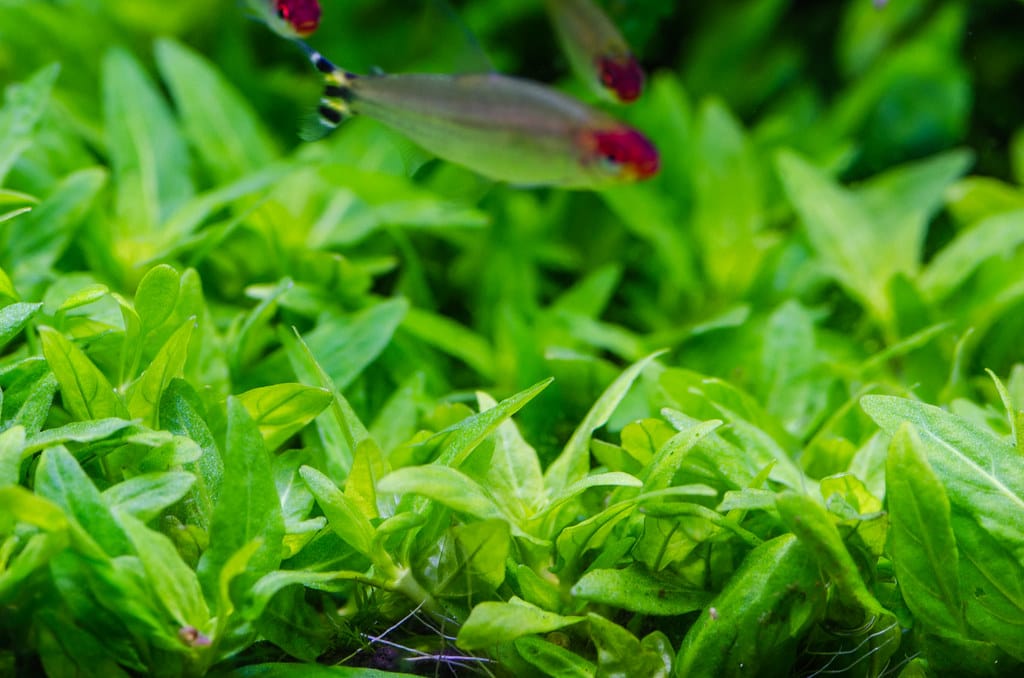
While technically a midground plant, Staurogyne repens can be trimmed and planted densely to create a rugged, unconventional carpet. It’s hardy and grows well even without CO₂.
✅ Best for: Low-tech tanks and unique textures
✅ Lighting: Moderate
✅ CO₂: Optional
✅ Growth rate: Moderate
✅ Why choose it: Adds depth and texture with minimal demands.
⭐ 7. Cryptocoryne parva
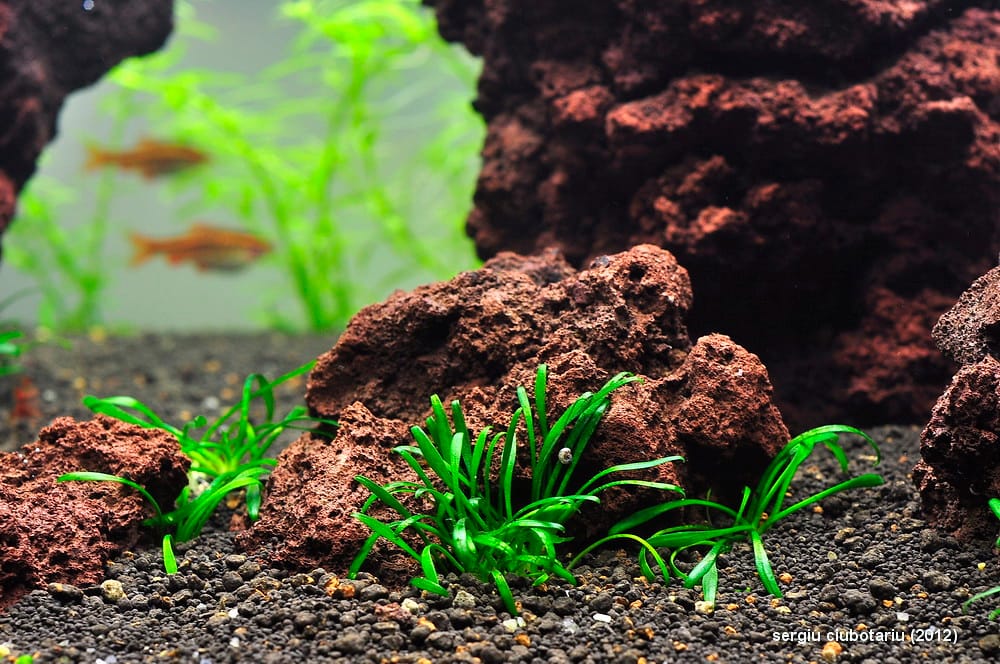
If you want a truly low-maintenance carpet, Cryptocoryne parva is an excellent option. It’s one of the smallest Crypts and tolerates low light and no CO₂, though it grows extremely slowly.
✅ Best for: Low-tech, low-light tanks
✅ Lighting: Low to moderate
✅ CO₂: Optional
✅ Growth rate: Very slow
✅ Why choose it: Minimal care and perfect for patient aquarists.
🌱 How to Plant and Maintain Carpet Plants
Getting a lush, healthy carpet starts with proper planting and ongoing maintenance. Here are some tips to help your carpet thrive:
🪴 Planting Tips
- Prepare the substrate: Fine-grain planted-tank soil works best for most carpet plants, providing nutrients and stability. Sand or gravel can work for hardy species like Dwarf Sagittaria, but growth may be slower.
- Divide into small clumps: When planting, break the plant into small plugs or tufts and space them about 1–2 cm apart. This encourages horizontal spreading.
- Use planting tools: Long tweezers make it much easier to plant carpet species deeply and neatly without uprooting.
✂️ Maintenance Tips
- Trim regularly: Many carpet plants grow vertically if left alone. Frequent trimming encourages horizontal growth and keeps the carpet dense.
- Vacuum gently: During water changes, use a siphon carefully to avoid disturbing the delicate roots.
- Control algae: Healthy growth and proper light balance prevent algae from overtaking your carpet.
- Fertilise appropriately: Use root tabs or liquid fertilisers if your substrate is nutrient-poor, especially for demanding species.
Make sure you’re understanding aquarium water parameters before introducing carpeting plants.
If you plan to keep shrimp alongside carpets, see our advice on how to care for freshwater shrimp.
🌱 Common Mistakes to Avoid
Even experienced aquarists sometimes struggle to establish a healthy carpet. Avoid these common pitfalls to ensure your carpet plants thrive:
❌ Choosing the Wrong Plant for Your Setup
One of the biggest mistakes is picking a high-demand plant like Glossostigma or Monte Carlo for a low-tech tank without adequate lighting or CO₂. Always match the plant’s needs to your tank’s conditions.
❌ Insufficient Light
Since carpet plants grow low to the substrate, light penetration is critical. Weak or poorly distributed lighting leads to sparse, upward-growing, or melting carpets.
❌ Skipping CO₂ in a High-Tech Design
If you’re attempting a high-density, competition-style carpet, CO₂ injection is almost always necessary. Skipping it can result in slow or patchy growth, even if you have strong lighting.
❌ Planting Too Sparsely
Planting just a few clumps far apart makes it harder for the carpet to establish itself. Always plant densely enough for the runners to connect quickly.
By avoiding these mistakes and staying consistent with care, you’ll be rewarded with a thick, vibrant carpet that transforms your aquarium.
Want to learn more about avoiding common pitfalls? Reading our guide to avoiding aquarium mistakes.
🌱 Closing Thoughts
Carpet plants are one of the most rewarding elements you can add to your aquarium. They create a stunning, natural look, improve your tank’s health, and provide shelter for small fish and shrimp. By understanding the needs of each plant and matching them to your setup — whether low-tech or high-tech — you can achieve a lush, thriving carpet that enhances your aquascape.
Take your time to choose the right plant, prepare your substrate properly, and maintain your carpet with regular trimming and care. Before you know it, you’ll have a beautiful underwater “lawn” that’s the envy of any aquarist.
For more tips on aquascaping and freshwater plant care, explore our other guides on aquarium plant species care and aquascaping styles.

